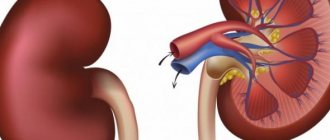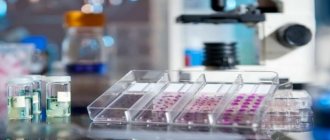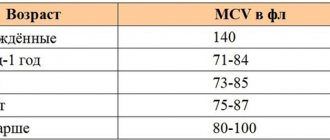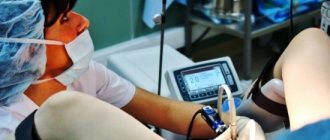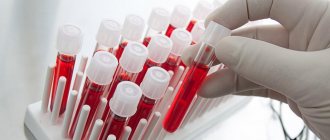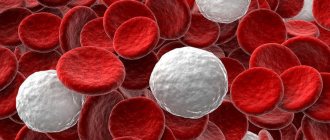© Author: A. Olesya Valerievna, candidate of medical sciences, practicing physician, teacher at a medical university, especially for SosudInfo.ru (about the authors)
Erythrocytosis is a condition characterized by an increase in the content of red blood cells - erythrocytes - in the blood. If we consider it as a purely laboratory indicator, it is easy to see that it is characteristic of an extremely large number of conditions, and in some cases it is even physiological in nature.
Depending on the root cause, there are several types of erythrocytosis, which also differ in symptoms, so approaches to therapy also differ. In each case, when an increase in red blood cells is detected in a patient, a full examination is necessary in order to determine the causes of the pathology and measures to combat it.
A little about blood
Blood is made up of two different parts. The first is the liquid part, or plasma. It contains various ions, organic molecules, proteins, enzymes and other active substances, as well as metabolic products of organs and tissues.
The second part of the blood consists of cellular, or formed elements. Most of all we have in our blood are erythrocytes, or red blood cells. Their main function is gas exchange. In the lungs they are saturated with oxygen and release carbon dioxide into the exhaled air, and in the smallest capillaries of all organs and tissues the reverse process occurs. Red blood cells are donors of oxygen to ensure tissue respiration, and take away the products of gas exchange, that is, they are saturated with carbon dioxide. All this is possible thanks to the complex protein hemoglobin, the molecule of which contains an iron atom. This is why our blood is red. Marine invertebrates have cobalt in their blood instead of iron, which is why the blood of cuttlefish, mollusks and octopuses is blue.
In addition to red blood cells, there are platelets, or platelets, in the blood. These are the smallest formed elements; they are involved in blood clotting, or hemostasis processes. Finally, the last and very variegated group consists of white blood cells, or leukocytes. They contain neutrophils, eosinophils, basophils, lymphocytes and monocytes. Their task is to protect the body from microorganisms, destroy them directly, by phagocytosis, or release special mediators that lead to the mobilization of immunity through the production of antibodies.
Normal red blood cell count
The production of red blood cells occurs in the red bone marrow. This process is called erythropoiesis and occurs in several stages. The main purpose of these cells is to transport oxygen and the product of the respiratory process - carbon dioxide. This is caused by hemoglobin contained in red blood cells. However, this is not the only thing that cells are intended for; in addition to ensuring tissue respiration, red blood cells perform the following functions:
- Nutritious. Red blood cells carry amino acids from the digestive system to other tissues of the body.
- Enzymatic. Enzymatic reactions are carried out with the participation of red blood cells due to the fact that enzymes can attach to the surface of the cells.
- Protective. Antigens and toxins can also be attached to the surface of red blood cells, causing them to become inactive in human blood. In addition, immune and autoimmune reactions in the body occur with their participation.
- Regulatory. The acid-base balance in the body is maintained by red blood cells.
The variety of functions performed by red blood cells explains how important it is for the health of the body that the number of red blood cells in the blood is normal. For adult men, the norm is 4-5.5 trillion/l
For women the norm is slightly lower, for children the normal value fluctuates. The norm is determined depending on age and gender factors.
What is erythrocytosis?
When we talk about erythrocytosis, what we really mean is an excess of red blood cells. It is known that in an adult the maximum number of red blood cells is approximately five billion in one liter, or 10*12/l. At the same time, women have slightly fewer red blood cells than men. Every day in a human body weighing 70 kg, the bone marrow produces about 200 - 250 billion new red blood cells, that is, 35 times more than there are people living on our planet, and the same amount is utilized.
And therefore, if a general blood test reveals more red blood cells in a woman than 4.7*1012/l, and in a man more than 5.5*1012/l, then we are talking about erythrocytosis. It turns out that erythrocytosis is not a disease, but for now just a laboratory phenomenon, “until newly discovered circumstances are identified,” as lawyers say. What can this phenomenon tell the doctor?
First of all, this means that the mass of circulating erythrocytes exceeds normal values, and laboratory, reliable erythrocytosis is spoken of when such a mass is more than 125% of the norm for a person of a given body weight. To determine whether the mass of circulating red blood cells is indeed increased, a rather complex isotope study is carried out. They are labeled with an isotope of chromium, Cr-51. If this study is not performed, then erythrocytosis should be diagnosed using additional diagnostic methods.
Red blood cells of living things
Red blood cells are an integral part of the blood not only of humans, but also of all vertebrates and a number of invertebrate creatures.
The nuclear-free design makes the red blood cells of mammals the champions of small size, but in birds, despite the preserved nuclei, the red blood cells are not much larger.
In other vertebrates, red blood cells are larger due to the presence of a nucleus and other constituent elements of the cell.
Normocytes (fully formed mammalian red cells) lack nuclei, intracellular membranes, and most organelles. After the nuclei in the cell primordia fulfill their role, they are forced out of them.
The main constituent element of the red blood cells of all living beings is hemoglobin. Nature has done everything possible to ensure that red blood cells can carry the maximum amount of oxygen.
In most living things, red blood cells are like round discs, but there are exceptions to every rule. In camels and some other animals, the red blood cells are oval.
Video:
https://youtube.com/watch?v=hOugDDzX-sg
The cell membranes of red blood cells also have a special role - they perfectly allow sodium and potassium ions, water and, of course, gases - oxygen and carbon dioxide - to pass through.
Red blood cell membranes owe their permeability to transmembrane proteins glycophorins, which negatively charge their surface.
Outside the membrane there are also so-called agglutinogens - blood group factors, of which over 15 are known today. The most famous of them is the Rh factor.
The functions of red blood cells depend on their number, and it depends on age. A reduced number of red cells is called erythropenia, and an increased number is called erythrocytosis.
Norms of red blood cells depending on age:
| Category | Quantity (million pieces per 1 mm³) |
| Men | 4,5 — 5,5 |
| Women | 3,9 — 4,7 |
| Newborns | Up to 6 |
| Aged people | Up to 4 |
The efficiency of hemoglobin directly depends on the area of contact of the red blood cell.
The fewer red blood cells there are in the bloodstream, the larger the total area of all red blood cells in the body. The red blood cells of lower vertebrates are quite large compared to higher ones.
For example, the diameter of red blood cells in amphiums (a type of amphibian) is 70 microns, and in goats, which are mammals, it is 4 microns.
Types of erythrocytosis
There are two large groups of erythrocytoses. These are absolute and relative erythrocytosis. An increase in the mass of red blood cells is absolute erythrocytosis. But if their number, or the total mass of red blood cells, is not increased, but the blood plasma in which the cells are located has become less than necessary, then as a result their relative concentration per unit volume will be higher. And therefore, at first glance, the result will be the same. It is not clear whether there are too many cells or too little fluid. Therefore, in order to understand what type of erythrocytosis exists in a patient, you must always know the total volume of circulating blood, or the volume of the liquid part of the plasma in which the red blood cells are located.
Contraindications
Contraindications to erythrocytepheresis are divided into absolute and relative. The first category includes:
- open areas of bleeding or increased risk of their occurrence;
- purulent-septic processes in the body;
- allergic reactions to components used during the procedure.
Relative contraindications include diseases and conditions in which the procedure can be performed after some time or under strict medical supervision:
- cardiovascular pathologies in the stage of decompensation;
- infectious diseases or exacerbations of chronic diseases;
- decreased hemoglobin and protein levels;
- thrombophlebitis;
- decreased blood pressure;
- blood clotting disorder;
- narrowing of the lumen of the veins;
- alcohol or drug intoxication and their consequences (withdrawal syndrome);
- mental illness;
- menstruation and pregnancy.
Causes of relative erythrocytosis
Naturally, hematologists are interested in absolute erythrocytosis, when for some reason there is an increased production of red blood cells. With relative erythrocytosis, everything is more or less clear.
It can be caused by prolonged diarrhea due to acute intestinal infections, dehydration due to severe sweating, being in a hot climate, intense physical work, and fluid restriction.
Quite often, relative erythrocytosis can occur in elderly people with diseases of the cardiovascular system due to an overdose of diuretics. The development of hypokalemia associated with an overdose of diuretics is written in this article. Relative erythrocytosis also occurs with repeated vomiting. Bad habits such as smoking and alcoholism lead to chronic relative erythrocytosis.
Once the doctor has determined that the causes of erythrocytosis lie in a lack of fluid in the body, the patient no longer needs to consult a hematologist. Therefore, we will continue to be interested only in absolute erythrocytosis, when the amount of blood plasma is normal, but for some reason an excess of red blood cells is produced.
Let's say right away that there is completely normal physiological erythrocytosis. Those people who live in the mountains, such as the Sherpas who live at altitudes above 3 - 4 thousand meters, necessarily have more red blood cells, since the partial pressure of oxygen at such altitudes is too low, and in order to ensure adequate gas exchange, simply more red blood cells are needed. This is a healthy, physiological absolute erythrocytosis in men and the same erythrocytosis in women. But it is always slightly expressed, always controlled by the red bone marrow, and if a person descends to the plain, then after some time the number of red blood cells will decrease, since the partial pressure of oxygen on the plain is significantly higher.
Next we will talk about pathological true erythrocytosis, which can be either congenital, hereditary, or acquired.
Types of pathologies
An increased number of red blood cells in the bloodstream reflects the human body’s ability to adapt to pathologies, which can be very different.
Most often, the symptoms of the disease at the initial stage of erythrocytosis are very mild; only a general blood test (CBC) can make it clear to doctors that some malfunctions are occurring in the body’s functioning.
It is very important to start treatment in a timely manner so that diseases do not develop to an irreversible stage. The norm of red blood cells in the blood is usually taken as the number of cells per liter or microliter of blood - 10¹²/l (µl)
The norm of red blood cells in the blood is usually taken to be the number of cells per liter or microliter of blood - 10¹²/l (µl).
Moreover, depending on the sex of a person, normal concentrations of red blood cells in the bloodstream may deviate from the average values.
Thus, in women the number of red cells averages 3.4-5.2 × 10¹²/l. In men, these figures are slightly higher - 4.3-5.7 × 10¹²/l.
The classification of erythrocytosis has three main forms, each of which has its own underlying cause:
- primary erythrocytosis (or true);
- absolute erythrocytosis (or secondary);
- relative erythrocytosis, which is also called Heisbeck syndrome.
True erythrocytosis is most often caused by inherited blood diseases, so this type of pathology is quite rare.
However, the following diseases can also cause primary erythrocytosis:
- heart disease;
- chronic gastritis;
- chronic obstructive pulmonary disease, most often observed in smokers;
- Oncological neoplasms can be the causes of true erythrocytosis and erythremia (or Vaquez syndrome).
If a person lives high in the mountains, then he may experience symptoms of physiological true erythrocytosis.
Since the oxygen content in the air decreases as the area rises above sea level, there is less of it in the body than it should normally be.
The process of physiological erythrocytosis is quite slow, the blood tests of those people who come to the highlands just to ski for one or two weeks will be normal, but for those who constantly live in conditions of oxygen deficiency, an increased concentration of red blood cells will be observed in the CBC.
Newly born children also experience symptoms of physiological erythrocytosis, since in the fertilized egg the child received oxygen only from the mother’s blood, and there was not very much of it.
Immediately after birth, children have an increased concentration of red blood cells in the CBC, which then, after two to three days, normalizes.
True erythrocytosis, what causes them?
It should be recalled that the number of red blood cells in the body depends on a special hormone, or erythropoietin. It is produced in the kidneys, and the liver, spleen and heart take part in its regulation. Erythropoietin affects the red bone marrow and causes it to produce more red blood cells. When the oxygen pressure in the tissues decreases in the kidneys, hypoxia occurs, and after this the kidneys begin to intensively produce erythropoietin, giving a signal to the red bone marrow to increase production.
We already know that absolute erythrocytosis can be congenital due to hereditary anomalies, and acquired. Let us list some of the most common causes of true erythrocytosis, in which the production of erythropoietin, a stimulator of erythropoiesis, or the synthesis of red blood cells, takes part:
- Chronic hypoxia (for example, chronic respiratory failure due to lung diseases);
- Various heart diseases;
- Long history of smoking;
- Carbon monoxide poisoning;
- Various tumors that secrete erythropoietin;
- Congenital heart defects, which cardiologists call “blue”, occur with diffuse cyanosis. This is the cause of erythrocytosis in children;
- Anomalies and stenosis of the renal artery.
All of these conditions lead to increased production of erythropoietin as the kidneys are starved of oxygen. This is all secondary erythrocytosis, since at first there was renal hypoxia, and then this blood reaction developed. All of these are symptomatic erythrocytosis, since here the blood reaction is a symptom of some other disease.
Classification
There are two forms of polycythemia - true and relative .
True erythremia , in turn, can be primary or secondary .
- Primary erythremia is an independent myeloproliferative disease in which the myeloid lineage of hematopoiesis is affected.
- Secondary polycythemia occurs when the activity of erythropoietin increases. Secondary erythrocytosis (also called “symptomatic erythrocytosis”) is a compensatory reaction to general hypoxia . Symptomatic erythrocytosis can develop in patients with a chronic form of pulmonary pathology, adrenal tumors, heart defects, etc. Physiological erythrocytosis is sometimes noted during ascent to altitude.
The relative form of the disease is noted if the level of red blood cells is normal, but the plasma volume decreases. This condition is also called polycythemia pseudo or stress polycythemia .
Vaquez disease (erythremia)
However, among all absolute erythrocytosis, the so-called erythremia, or Vaquez's disease, occupies a special place. Also called polycythemia vera. This disease belongs to acquired primary erythrocytosis, and with erythremia, all blood cells, red blood cells, white cells, and platelets begin to multiply uncontrollably. But since there are many more red blood cells, true erythrocytosis develops first.
In 2005, it was revealed that this disease develops as a result of a point, minor gene mutation. In total, in DNA, in one section of chromosome 9p24, in its exon No. 14 at place 1849, a replacement of one base with another occurred. It would seem a trifle, but: “there was no nail - the horseshoe was missing, there was no horseshoe - the horse went lame...”, and so on.
Due to mutation, guanine is replaced by thymine. When a protein is synthesized from an RNA template complementary to this code, phenylalanine appears in the protein instead of the amino acid valine. As a result, as they like to write in illiterate medical articles, “a failure occurred,” but here it really happened, there was a constant activation of special structures that produce blood cells. Therefore, the precursor cells, which are called hematopoietic, can no longer be stopped.
How often does such an interesting mutation appear? With a frequency of one case per 100 thousand people annually. The average age of patients is 60 years and older. Very rarely, polycythemia occurs in people under 40 years of age, or one case in 2 million people. Vaquez disease is never the cause of erythrocytosis in children.
Diagnosis criteria
Erythrocytosis can occur in any age group, so it is extremely important to properly diagnose this condition. Laboratory and instrumental studies, as well as patient examination data, will help with this.
First, you need to take a general blood test, which will reflect the levels of red blood cells, hemoglobin, hematocrit and other cells. Table 2 presents data from a general blood test depending on the stage of erythrocytosis.
Table 2. General blood test indicators for erythrocytosis.
| Index | initial stage | Erythremic stage | Anemic stage |
| Red blood cell count | M: 5.7 – 7.5 x 10*12/l | more than 8 x 10*12/l | less than 3 x 10*12/l |
| F: 5.2 – 7 x 10*12/l | more than 7.5 x 10*12/l | less than 2.5 x 10*12/l | |
| Platelet count | 180 – 400 x 10*9/l | more than 400 x 10*9/l | less than 150 x 10*9/l |
| White blood cell count | not changed | more than 12 x 10*9/l (in the absence of infection or intoxication) | less than 4.0 x 10*9/l |
| Reticulocyte count | M: not changed | more than 2% | may be normal, increased or decreased |
| F: not changed | more than 2.5% | ||
| Total amount of hemoglobin | M: 130 – 185 g/l | more than 185 g/l | less than 130 g/l |
| F: 120 – 165 g/l | more than 165 g/l | less than 120 g/l | |
| Color index | not changed | less than 0.8 | may be normal, increased or decreased |
| Hematocrit | M: 42 – 52% | 53 – 60% and above | less than 40% |
| F: 38 – 50% | 51 – 60% and above | less than 35% | |
| Erythrocyte sedimentation rate | M: 2 – 10 mm/hour | 0 – 2 mm/hour | more than 10 mm/hour |
| F: 3 – 15 mm/hour | 0 – 3 mm/hour | more than 15 mm/hour |
Note: M – men, F – women.
An ultrasound examination (ultrasound) of the kidneys, heart, blood vessels, spleen and liver can be performed to assess the size, condition of the circulatory system, and the presence of blood clots. The gas composition of the blood will make it possible to find out whether the increase in red blood cells occurred as a result of a lack of oxygen or whether there were other reasons for this. A bone marrow puncture can be performed, which will evaluate the processes of synthesis of hematopoietic cells and determine the stage.
Determination of erythropoietin concentration. At the initial and erythremic stages, its synthesis is inhibited by an increased number of red blood cells. In the anemic stage, on the contrary, a low level stimulates increased production of the hormone by the kidneys.
Signs and symptoms
Symptoms and signs of the most severe type of erythrocytosis, erythremia, are quite characteristic, but do not appear immediately. Usually, at the onset of the disease, only erythrocytosis is visible, and due to thickening of the blood, patients experience high blood pressure, cyanosis of the fingers and toes, itching of the skin after washing, pain and loss of sensitivity in the fingertips. Blood thickening leads to impaired microcirculation.
At the second stage, patients with Vaquez disease already have other laboratory phenomena: high leukocytosis due to neutrophils and a shift of the formula to the left. Under normal conditions, such production of leukocytes is characteristic of acute infectious diseases with very high temperatures. In this case, the body is clear, and the red bone marrow throws all its reserves into fighting the infection. And here he simply cannot stop. It is important that this is not “blood cancer” or leukemia. With leukemia, a huge number of immature blasts are produced, which are of no use, only harm. And here, while the bone marrow is working hard, it just produces a lot of normal cells.
Then the platelet count increases, and the spleen, which is a lymphoproliferative organ and must destroy all this excess blood cells, works under extremely great stress, and, in the end, its structure is disrupted.
Blood viscosity is high, blood flow slows down. Various thromboses occur, ischemia of organs and tissues develops, and these are all elderly people. Patients have a very high risk of ischemic strokes, heart attacks, and thrombosis of the intestinal mesenteric vessels. About 30% of patients with erythremia die from venous thrombosis.
The condition is aggravated by the occurrence of hemorrhagic bleeding: from the nose, after tooth extraction. Bleeding from a gastric ulcer in these patients is life-threatening. They may ask: Why the bleeding? After all, we are talking about the opposite – about thrombosis? The insidiousness of erythremia is that thrombosis occurs inside the vessels from blood thickening, and during bleeding, when the hemostasis mechanism is triggered, this density prevents the normal retraction of the blood clot.
Towards the end of this stage, so-called myeloid metaplasia of the spleen is added. It simply cannot process such an extra volume of blood cells, and cannot serve as a cemetery for red blood cells. Simply put, she refuses to work. The spleen is enlarged, its functional tissue is replaced by connective tissue, and fibrosis occurs.
Finally, the bone marrow can no longer cope with the excessive production of blood cells. It is replaced by the same scar tissue, and ceases to produce even the normal number of cells. Anemia develops, the platelet count drops, and hemorrhagic syndrome develops in full. These are the symptoms of erythrocytosis, which are most dramatic and unfold precisely with erythremia.
Finally, after a long and many-year period of such perverted activity and excessive stress, the bone marrow, in addition to its complete devastation, may begin to produce immature blood cells and the patient will be diagnosed with acute myeloid leukemia. That is, the outcome of erythremia can be not only myelodysplastic syndrome, but also leukemia, or blood cancer.
Symptoms of the disease
Erythrocytosis, you already figured out what it is, may have the following symptoms:
- Redness of the skin, although with the relative type of the disease the color does not change.
- High arterial hypertension.
- Abnormal pathological enlargement of the spleen.
- Headache.
- Weakness, fatigue too quickly, drowsiness. These symptoms occur because the blood becomes too thick and requires extra effort to pump it.
Diagnosis of Vaquez disease
Erythremia is diagnosed according to the standard, and very accurately, playing out the moves, like in a chess game, the algorithm is very strict:
- A high level of hemoglobin is detected (over 165 g/l for men and 160 for women);
- An analysis of hematocrit (blood density) is carried out, it is also high: over 49% for men and 48% for women;
- According to the results of bone marrow puncture, proliferation of all 3 lineages was revealed: erythrocytes, leukocytes and platelets.
Already at this stage the diagnosis is more than likely. But you still need to check your erythropoietin level. Naturally, polycythemia vera does not depend on it, and it will be normal, or even slightly reduced.
The most important thing is that genetic analysis reveals a specific point mutation of the gene in the above-described chromosomal locus. Now it's possible. That's it, the diagnosis is 100% clear. How to treat erythrocytosis with such a severe course?
Forecast
Depending on the root cause, the prognosis can take on very different values. The sooner the cause is identified and eliminated, the greater the chance that neither the root cause nor erythrocytosis, as a symptom, will recur.
In hereditary erythrocytosis, it is important to control the concentration of red blood cells and thin the blood to prevent the formation of blood clots. If erythrocytosis is not yet a critical pathology, then blood clots can pose a real threat to the patient’s life
This problem is solved with the help of anticoagulants and blood thinning drugs, periodic bloodletting, and staying in an area far from industrial facilities and large cities.
Treatment
Since the treatment of erythremia is the standard of complete therapy for erythrocytosis, we will dwell on it a little. It is very important to prevent thrombosis and ischemic conditions as early as possible. It is imperative to give the patient aspirin in a sufficiently high dose to prevent microcirculatory disorders. Curantil, pentoxifylline and Trental are indicated.
To reduce the amount of blood and to reduce its density, bloodletting is periodically performed. Vaquez's disease is one of the few where medieval techniques bring true relief. But bloodletting is not recommended if the hematocrit does not exceed 0.54. But when it reaches this mark, and the amount of cellular composition of the blood exceeds the liquid part, they are performed.
After bloodletting, the patient is injected with a similar amount of isotonic sodium chloride solution, that is, basic blood thinning occurs. However, it should be remembered that in addition to excess red blood cells and other blood cells, the patient loses iron during bloodletting, and this must be corrected. To do this, the total iron-binding capacity of the serum is controlled, iron, ferritin and transferrin are taken.
For the purpose of pathogenetic treatment of Vaquez disease, immune drugs are used: alpha interferon, hydroxyurea, and other agents. All of these medications significantly reduce bone marrow activity. Unfortunately, the last stage of erythremia does not currently have effective treatment methods, when anemia already develops or leukemia occurs.
Prognosis for severe erythrocytosis - Vaquez disease
If we talk about the prognosis of erythremia, as a representative of severe true, absolute erythrocytosis, then we can still call it favorable if treatment is started in the early stages and continues continuously. What does a favorable prognosis mean? Once diagnosed early, 65% of patients survive the next 10 years.
These numbers may seem terrible to some, but it should be remembered that polycythemia vera is not detected at a young age, but usually after 60 years. And with proper treatment, the patient may well live to an average life expectancy. Of course, vascular thrombosis in old age in patients over 60 years of age is the main danger in this serious illness, which began with such an innocent phenomenon as “a lot of red blood cells.”
https://youtu.be/Lcjs_PZOOA0
Traditional medicine recipes
Such recipes, if desired, can be found not only on the Internet, but also in the recommendations of the traditional doctors who use them. Without questioning them, it is still worth emphasizing that one must resort to such methods of treatment very carefully, subject to mandatory consultation with professional doctors. Among the useful recipes of traditional medicine it is necessary to highlight:
- 100 grams of dried dill seeds are ground into powder in a coffee grinder. Use the product 2 times a day, 1 tsp, dissolving in the mouth for about five minutes, and then wash it down with water. This must be done for two months. The powder should be stored closed in a dark place.
- A mixture of herbs is prepared, which includes fireweed, wormwood and mint leaves. Take 1 tsp. mixture and pour 1 liter. boiling water, let the infusion stand for 40 minutes, and then filter. Take a decoction of 0.5 tbsp. before meals 3 times throughout the day. The course of treatment is three weeks,
- 1 tbsp. kefir is mixed with 0.5 tsp. dried wormwood flowers, pre-chopped. The drink is consumed at night for seven days, then a week break is taken and the course is repeated again. In addition to improving red blood cell counts, the recipe helps the liver function effectively,
- 100 gr. 0.5 l of nutmeg is poured. Vodka and infuse for three weeks, while the container with the drink should be shaken daily. Before use, the folk remedy is filtered and taken 25 drops, which are diluted with a little water. The intake is carried out before eating food, and the duration of the course is carried out until the tincture is completed. It is recommended to carry out five courses, taking a 10-day break between each one,
- Take honey and chopped garlic in equal parts. The product is allowed to stand for three weeks, and then they begin to take 1 tbsp 30 minutes before a meal. l.
